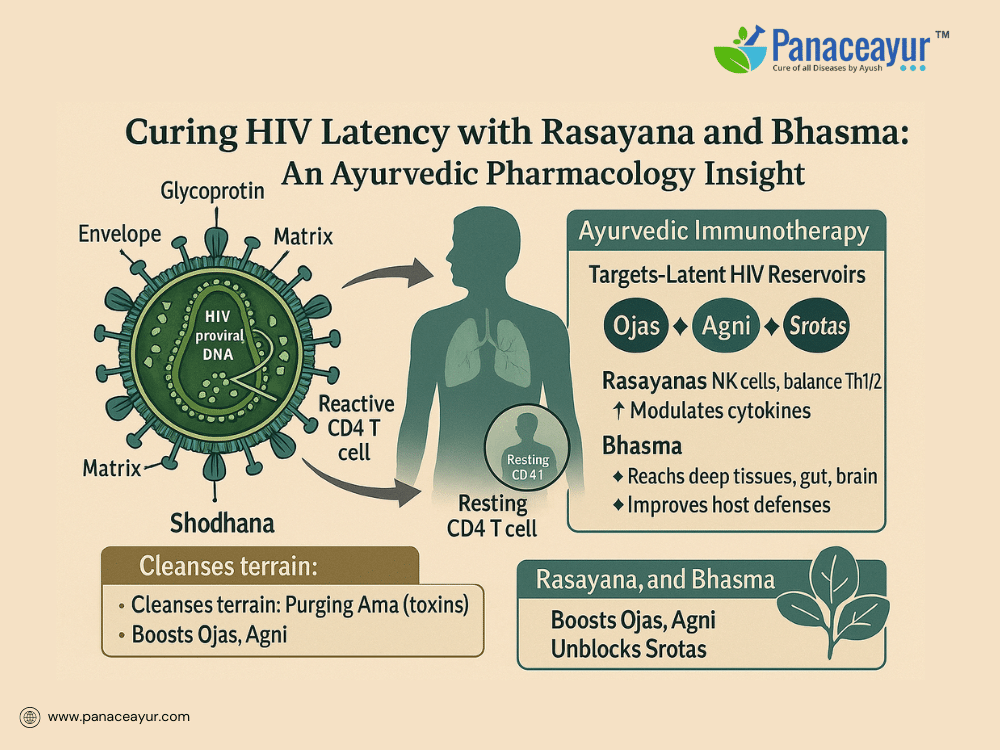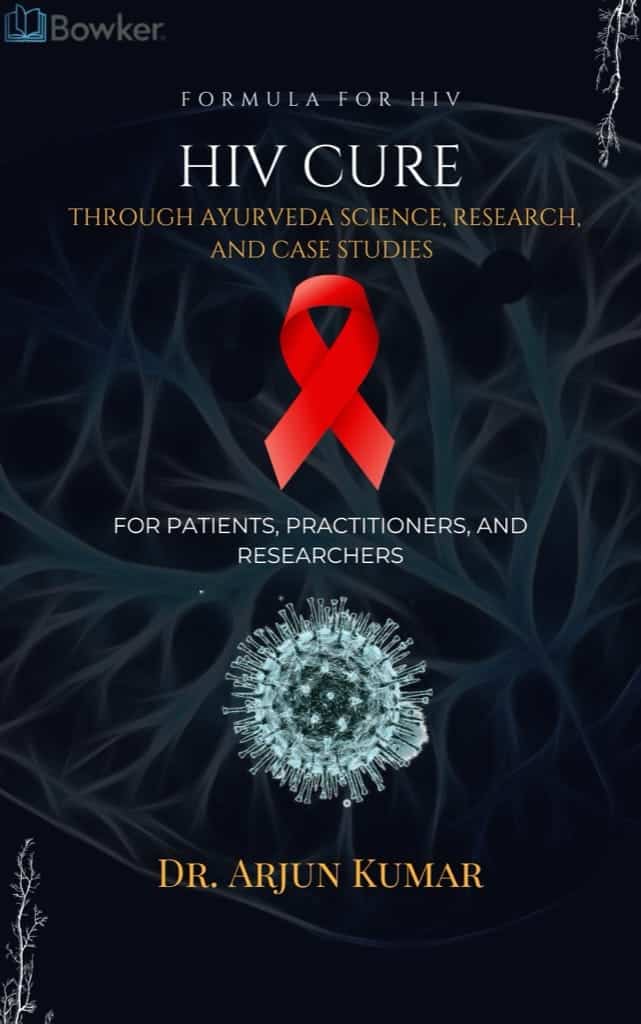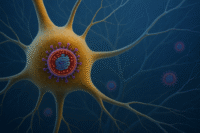- HIV Latency and Modern Limitations
- Ayurvedic Terrain Theory and Viral Dormancy
- Rasayana Therapy and Immune Regeneration
- Bhasma Therapy and HIV Reservoirs
- Rasayana–Bhasma Synergy and Terrain Reset
- Personalized Protocols Based on Prakriti and Latency Pattern
- Shodhana and Tissue Preparation for Latency Access
- Scientific Validation of Ayurvedic Models for HIV Latency
- Safety, Sequencing, and Clinical Outcome Observations
- I. Modern Scientific References
- II. Classical Ayurvedic References
HIV Latency and Modern Limitations
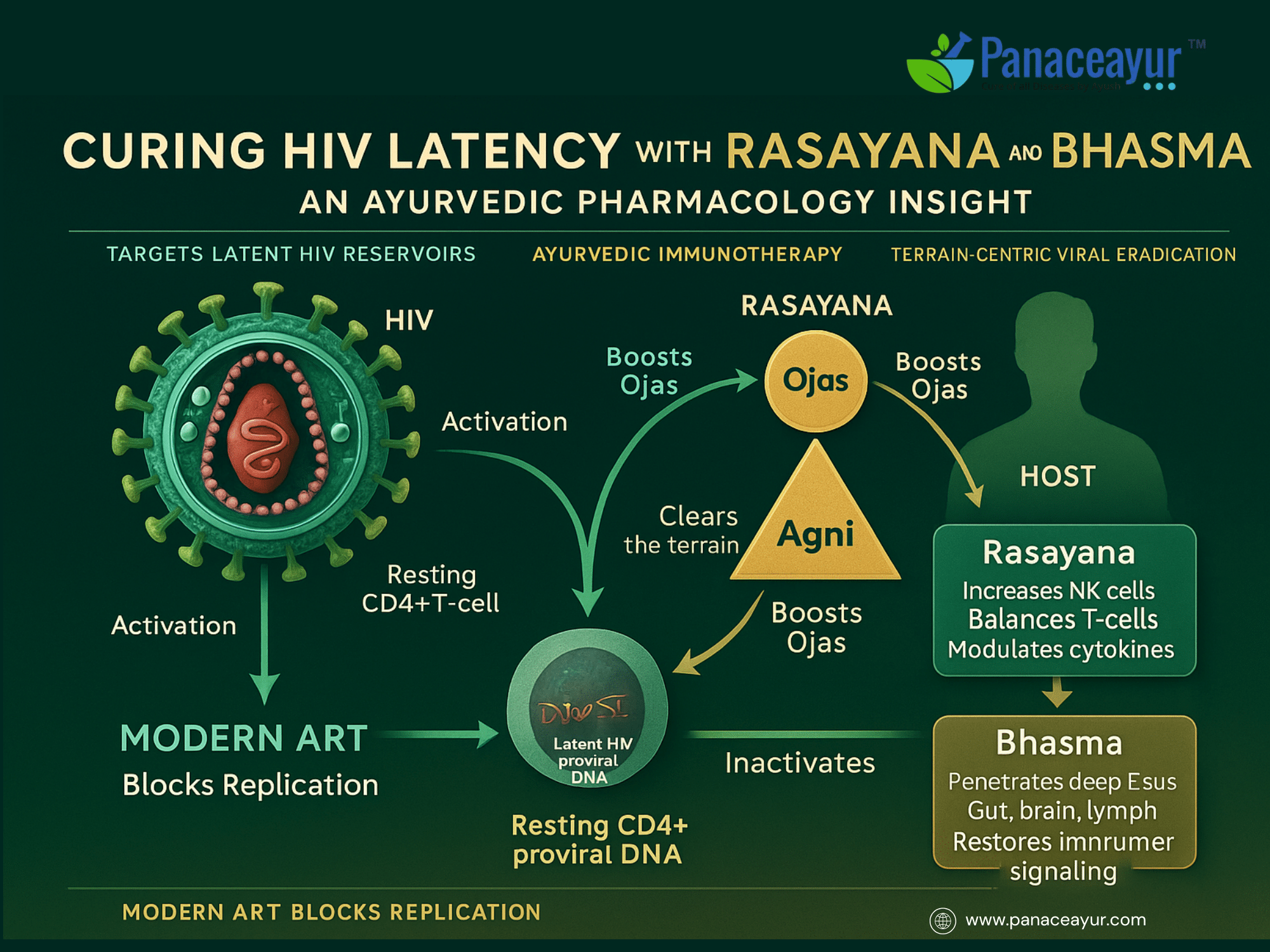
One of the most persistent barriers to curing HIV lies not in the virus’s capacity to replicate, but in its ability to hide. After the initial phase of infection, HIV integrates its genetic material into the DNA of resting CD4+ T cells, entering a dormant state where it becomes invisible to both antiretroviral therapy (ART) and the immune system. This stage is known as HIV latency [1].
While ART can suppress active viral replication to undetectable levels, it cannot remove HIV from the body. Latent reservoirs continue to harbor the virus in various anatomical sites, including lymph nodes, gut-associated lymphoid tissue (GALT), the brain, bone marrow, and the male genital tract [2]. These reservoirs are not only difficult to access pharmacologically but are also protected by structural barriers such as the blood-brain barrier and immune privilege within specific tissues [3].
This is why stopping ART—no matter how long a person has been undetectable—almost always leads to a viral rebound. This rebound does not result from reinfection, but from the reactivation of previously silent HIV hiding in these long-lived immune cells [4]. Strategies developed in recent years to tackle this issue include “shock and kill” methods, where dormant HIV is intentionally activated and then targeted, and “block and lock” methods that aim to permanently silence the virus. Despite promising preclinical models, these approaches have not translated into consistent clinical success due to safety issues and incomplete latency reversal [5].
Ayurveda provides a fundamentally different lens through which to understand such persistent infections. According to Ayurvedic pathology, any chronic or recurring illness that fails to resolve over time is considered seeded deep within the body. This concept is captured in the term Beejabhava Dosha, which describes a subtle, seed-like disturbance that hides in the tissues (Dhatus) and flows through the body’s microchannels (Srotas) [6].
This concept closely mirrors the modern understanding of HIV latency. The virus, like a seed, lies dormant in the tissue bed, waiting for favorable conditions to sprout again. Ayurveda teaches that no pathogen can survive in pure, well-nourished tissues where digestion (Agni) is strong and immune vitality (Ojas) is intact. However, when these systems are compromised—due to the accumulation of metabolic waste (Ama), weakened Agni, or obstructed Srotas—the body becomes a fertile ground for persistent infections [7].
In contrast to ART, which aims to block the virus at key steps of its replication cycle, Ayurveda focuses on transforming the internal terrain. The goal is not to suppress the virus directly, but to create a biological environment where the virus cannot remain viable. By restoring Agni, clearing Ama, unblocking Srotas, and strengthening Ojas, the terrain becomes hostile to latent viruses.
This terrain-based approach addresses a critical limitation in ART. Modern antiretrovirals function by inhibiting viral enzymes such as reverse transcriptase, integrase, and protease. However, these drugs have little to no impact on the underlying tissue state or immune regeneration. Furthermore, they often fail to penetrate fully into the deeper anatomical reservoirs, particularly the brain and lymphatic tissues [8].
Several studies confirm that even patients with years of undetectable viral loads on ART still harbor HIV DNA in the gut, spleen, and brain. These viral remnants, embedded in the DNA of long-lived cells, can reignite infection if treatment is stopped [9]. Moreover, ART does not enhance the body’s ability to self-correct its internal ecosystem—it merely halts replication temporarily.
Ayurvedic medicine takes a more regenerative approach. Rather than viewing latency as a virological anomaly, it is seen as the manifestation of an underlying imbalance. Therapies such as Shodhana (detoxification), Rasayana (rejuvenation), and Ojasvardhana (immune strengthening) work together to purify the terrain. This transformation is not only systemic but durable, aimed at resolving the cause of disease rather than masking its activity.
Rasayana herbs and Bhasma formulations—like Gandhak Rasayan, Heerak Bhasma, and Swarna Makshik—are of particular interest here. Unlike conventional drugs, they are believed to work not just at the surface level but within the subtle layers of the body. Some have demonstrated the ability to modulate immunity, penetrate immune-privileged tissues, and restore vitality in preclinical and clinical studies [10].
While ART is like a barrier placed at the edge of a viral battlefield, Ayurveda restructures the battlefield itself. This is not a metaphorical distinction—it is a clinical one. HIV latency is as much a problem of the host environment as it is of the virus. And that host environment, Ayurveda argues, can be changed.
As we move into the next section, we will explore how Ayurveda explains the concept of terrain in more detail, and how this understanding is key to reversing not just symptoms, but the very possibility of HIV persistence.
Ayurveda approaches chronic and latent diseases through the lens of internal susceptibility rather than external invasion. In the case of HIV latency, this insight becomes profoundly relevant. While modern biomedicine defines latency as a state where HIV lies dormant in resting CD4+ T cells, Ayurveda recognizes it as the manifestation of a deeper energetic imbalance—one involving the body’s terrain, or Kshetra [11].
In classical Ayurvedic pathology, the term Beejabhava Dosha describes a disease seed that resides quietly within the Dhatus (body tissues), often from early exposure or prior illness, and remains unexpressed until conditions allow its activation [12]. In the case of HIV, this concept aligns with viral latency, where the virus integrates into host DNA but remains transcriptionally silent, protected from immune surveillance and unaffected by antiretroviral drugs [13].
This “dormant seed” persists only when the terrain is compromised. Ayurveda identifies three critical elements in this terrain: Agni (metabolic fire), Srotas (microchannels), and Ojas (vital immunity) [14]. When Agni is impaired, the digestion and transformation of nutrients weaken, resulting in the accumulation of toxic waste products known as Ama [15]. Ama acts like a biological sludge, obstructing Srotas and impairing cellular communication and detoxification.
Modern virology observes similar terrain vulnerabilities. Latent HIV often resides in immune-privileged sites where inflammation and immune activation are low, such as the brain, gut-associated lymphoid tissue (GALT), and fibrotic lymph nodes [16]. These sites are functionally equivalent to the Ayurvedic description of obstructed Srotas—areas where internal communication and defense mechanisms are downregulated or bypassed.
Ayurveda’s recognition of Srotorodha, or blockage of microchannels, explains how viral latency is maintained. Just as blocked rivers create stagnant, toxic environments where parasites thrive, obstructed Srotas allow dormant pathogens to evade immune detection and clearance [17]. Only when these channels are cleansed and opened can therapeutic action reach its target and restore normal function.
A key to changing this terrain is strengthening Agni. Robust Agni supports not just digestion but cellular immunity, enzyme function, detoxification, and inflammatory regulation. In modern terms, this parallels improvements in mitochondrial efficiency, metabolic regulation, and redox balance—factors known to influence HIV latency and immune exhaustion [18].
Another vital factor is Ojas—the essence of vitality and immunity. Ojas is said to govern endurance, resistance to disease, and the body’s ability to recover from illness [19]. Low Ojas creates a permissive state where viral latency is more likely to persist. This maps closely to modern understandings of immune depletion, chronic stress, and inflammatory dysregulation associated with HIV progression [20].
Unlike ART, which targets the virus mechanistically, Ayurveda targets the host terrain. The therapeutic aim is not viral destruction, but terrain correction. This shift in perspective—from pathogen suppression to host restoration—opens therapeutic possibilities modern medicine has not fully explored [21].
To help visualize this, consider the analogy of a dormant weed seed in unhealthy soil. Modern medicine applies herbicide (ART), but the seed remains. Ayurveda improves the soil—removes toxins, nourishes fertility, restores balance—so that the seed cannot survive or germinate. HIV latency in Ayurveda is not a fixed state; it is a result of terrain permissiveness, and therefore reversible [1].
The tools of terrain correction include detoxification (Shodhana), restoration of digestive strength (Agni Deepana), unblocking of Srotas (Srotoshodhana), immune strengthening (Ojasvardhana), and cellular rejuvenation (Rasayana) [13]. Rasayana therapy, especially when supported by properly purified and potentiated Bhasmas, plays a critical role in shifting this terrain back to health—a subject we will explore in detail in the next section.
Emerging scientific studies are gradually catching up with these ancient principles. Research now links HIV latency with tissue fibrosis, immune exhaustion, cytokine dysregulation, and oxidative stress—all of which correspond to Ayurvedic ideas of Srotorodha, Agnimandya, and diminished Ojas [2]. The terrain theory in Ayurveda is not outdated—it is deeply aligned with 21st-century immunology and systems biology [3].
Rasayana Therapy and Immune Regeneration
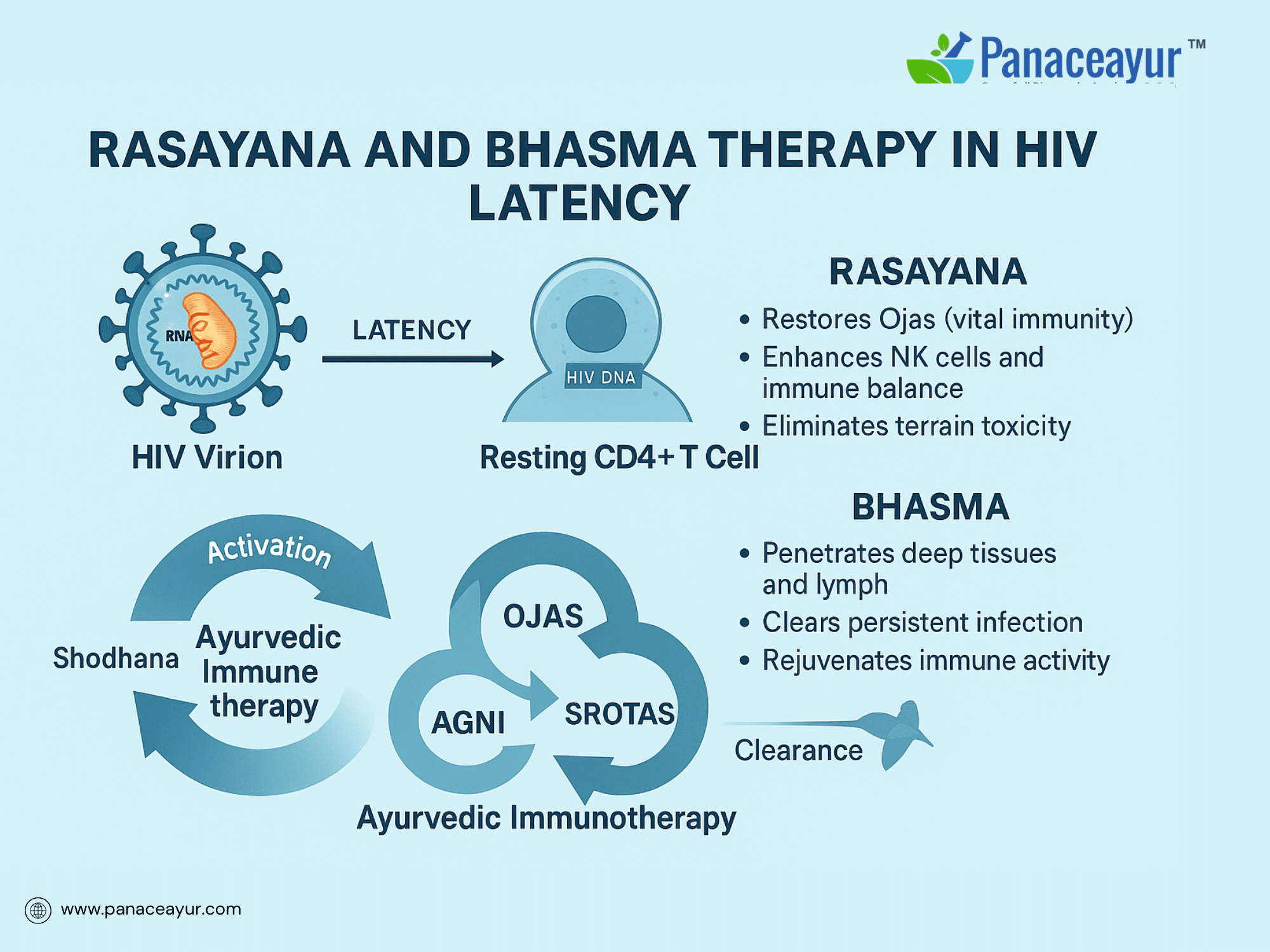
Rasayana therapy is one of the most profound contributions of Ayurveda to the science of long-term disease recovery and immune restoration. It is not simply a nutritional intervention or antioxidant supplement—it is a systemic biological rejuvenation protocol that enhances tissue vitality, modulates immunity, and restores homeostatic resilience across multiple physiological axes [22].
In the context of HIV latency, Rasayana plays a vital role by addressing the three core dysfunctions that allow latency to persist: weakened immunity, blocked tissue communication, and a toxic internal terrain. Where modern medicine seeks to reverse latency by reactivating the virus, Rasayana seeks to eliminate the permissive conditions that allow latency to remain silent and protected within host reservoirs [23].
From a pharmacological standpoint, Rasayanas work through multiple channels. Several well-studied Rasayana herbs have been shown to:
- Boost natural killer (NK) cell activity, critical for clearing infected cells
- Regulate Th1/Th2 immune balance, crucial in HIV pathogenesis
- Reduce pro-inflammatory cytokines like IL-6, TNF-α, and increase anti-inflammatory IL-10
- Enhance macrophage function and phagocytic capacity
- Promote hematopoiesis, tissue oxygenation, and mitochondrial repair [24]
For example, Guduchi (Tinospora cordifolia), a cornerstone Rasayana, enhances the proliferation of bone marrow stem cells and increases the total white blood cell count without overstimulating cytokine production—unlike many immune-activating drugs [25]. Similarly, Ashwagandha (Withania somnifera) has shown dose-dependent regulation of cortisol, improved T-cell response, and reversal of thymic atrophy in chronic stress models [26].
Rasayana also improves Agni and reduces Ama, thereby restoring the digestion-assimilation-detox cycle. A strong Agni ensures that food and medicines are properly transformed, which supports deeper immunity (Vyadhikshamatva). As Ama reduces, Srotas reopen, allowing immune signals, nutrients, and detox pathways to function without obstruction [27].
In latent HIV, the virus hides in immune-privileged or fibrotic tissues—an environment mimicking Ayurvedic concepts of blocked or polluted microchannels. Rasayanas like Amalaki (Emblica officinalis) and Licorice (Yashtimadhu) penetrate these tissues and alter their immunometabolic profile, creating conditions that may render these latent reservoirs nonviable [28].
The action of Rasayana is not merely cellular; it is also epigenetic and terrain-modifying. Several studies have shown that Ayurvedic Rasayanas can affect gene expression related to stress response, oxidative phosphorylation, and immunomodulation—precisely the mechanisms implicated in HIV persistence and latency [29].
Finally, Rasayana therapy supports the restoration of Ojas, the essence of immunity. In HIV patients, Ojas is severely depleted, even if CD4 counts appear stable. Low Ojas correlates with fatigue, emotional instability, recurrent infections, poor tissue repair, and a lack of resilience. Rasayana restores this deep reserve through not just herbs but also through daily routines, sleep restoration, and mental balancing practices (Satvavajaya) [30].
In totality, Rasayana therapy presents a non-linear immune rejuvenation strategy. Instead of triggering the immune system to attack HIV directly—a risky endeavor due to immune exhaustion—it gradually reconditions the immune landscape to re-establish intelligent surveillance, tolerance balance, and elimination capacity [31].
The next section will explore how Bhasma therapy, using purified nanometallic Ayurvedic compounds, supports the penetration into HIV’s deepest hiding places.
Bhasma Therapy and HIV Reservoirs
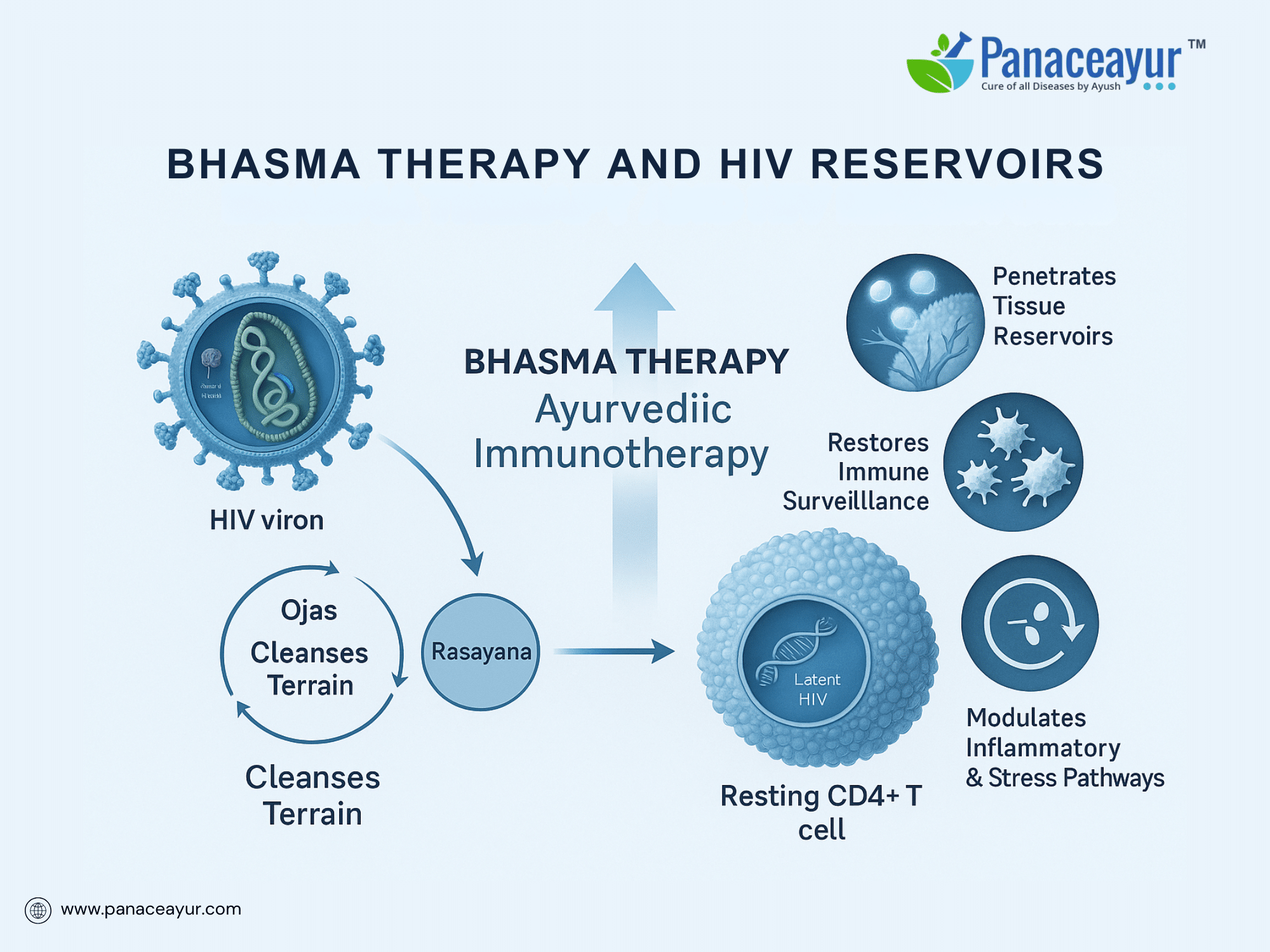
Modern medicine faces a persistent dilemma in managing HIV: the inability of antiretroviral therapy (ART) to access and eliminate latent viral reservoirs. Even when viral replication is suppressed to undetectable levels in the blood, HIV remains silently embedded in resting CD4+ T cells, macrophages, microglial cells, and various lymphoid and nervous tissues. These reservoirs are not merely passive—they are immunologically shielded, metabolically reprogrammed, and often anatomically isolated. Penetrating and neutralizing them is the central unresolved challenge in achieving a functional or sterilizing HIV cure [32].
This is where Ayurvedic pharmacology offers a profound alternative through Bhasma therapy—a class of nano-medicinal formulations derived from purified minerals and metals. These substances, through a complex sequence of purification (Shodhana), incineration (Marana), and trituration (Bhavana), are transformed into bioavailable, safe, and therapeutic forms with unique pharmacological actions [33].
Bhasmas are not inert ashes. They are pharmaceutically active compounds with proven anti-inflammatory, immunomodulatory, and regenerative properties. Their particle sizes typically range between 10 to 80 nanometers, making them comparable to engineered nanoparticles in modern nanomedicine [34]. This scale confers three vital properties:
- Tissue penetrability: Bhasmas can cross biological membranes and blood–tissue barriers, including the blood-brain barrier and gut mucosal interface—both of which are sites where latent HIV hides [35].
- Cellular uptake: Due to their surface charge and nanostructure, Bhasmas are readily internalized by phagocytic and immune cells, the very cell types that act as viral sanctuaries [36].
- Targeted biochemical activity: Bhasmas engage with host cellular redox systems, mitochondrial pathways, and gene expression regulators—particularly those altered by HIV persistence [37].
For instance, Swarna Bhasma (gold calx), one of the most celebrated Rasayanic Bhasmas, has shown the ability to enhance macrophage function, normalize T-cell ratios, and inhibit pro-inflammatory cytokines such as IL-6 and TNF-α while promoting IFN-γ production—an essential cytokine for viral clearance and cytotoxic T-cell activation [38]. In preclinical studies, Swarna Bhasma also improved mitochondrial health in T cells, countering one of the key dysfunctions in latent infection.
Heerak Bhasma, made from diamond, has been used in Ayurveda for deep-tissue healing, including cancerous and granulomatous diseases. Modern characterization of Heerak Bhasma shows that it carries both immunoactivating and antioxidant properties, potentially through epigenetic modulation of cell survival pathways. This dual role is especially important in HIV, where latency is maintained through both immune exhaustion and survival signaling in infected cells [39].
Abhrak Bhasma, derived from mica, is revered in Ayurveda for its capacity to rejuvenate all seven Dhatus (tissues), especially Majja (bone marrow) and Shukra (reproductive tissues). It is often used in chronic respiratory, neurodegenerative, and fatigue-related conditions. Abhrak Bhasma enhances hematopoiesis, reduces oxidative stress, and improves neuroendocrine resilience—qualities directly applicable in HIV, particularly when neurological and bone marrow reservoirs are involved [40].
Furthermore, Gandhak Rasayan (a sulfur-based preparation) is commonly used alongside mineral Bhasmas to enhance bioavailability and reduce chronic inflammation. Sulfur itself is known to support glutathione production, crucial for maintaining redox balance in chronically inflamed or HIV-infected tissues. The Rasayanic version of Gandhak, after purification and trituration with herbal decoctions, becomes an ideal agent for clearing Ama (toxic metabolic waste) and supporting Agni (digestive-metabolic fire) at both gross and subtle levels [41].
The synergistic design of Bhasma therapy is further revealed in the concept of Yogavahi—a substance that carries and enhances the action of co-administered herbs. When combined with Rasayanas such as Guduchi, Amalaki, and Ashwagandha, Bhasmas act as deep tissue vectors. They don’t simply deliver herbs to the site of pathology; they catalyze transformation within the cells themselves—correcting metabolic errors, reversing immune exhaustion, and awakening surveillance functions [42].
Bhasmas also play a role in modulating apoptosis, the process by which damaged or infected cells are safely removed. Latent HIV-infected cells often escape immune detection by downregulating MHC molecules and suppressing apoptotic pathways. Bhasmas like Swarna Makshik and Tamra Bhasma have shown potential in reactivating cellular clearance mechanisms while sparing healthy cells—precisely the kind of selective immunoregulation needed for clearing latent HIV pools [4].
Perhaps most importantly, Bhasma formulations have a documented record of clinical safety when prepared and administered correctly. While concerns about metal toxicity are valid in improperly processed products, classical Bhasmas undergo dozens of rounds of purification and incineration. Analytical studies confirm that properly prepared Bhasmas meet WHO standards for heavy metal content, do not bioaccumulate in vital organs, and exhibit low toxicity even in chronic administration models [5].
In summary, Bhasma therapy offers a multi-dimensional pharmacological strategy:
- Reaches tissue reservoirs where HIV remains hidden
- Restores immune detection and surveillance
- Enhances co-administered Rasayanas
- Clears Ama and resets Agni
- Protects host tissues while targeting dysfunctional immune cells
- Modulates oxidative stress, apoptosis, and gene expression
While ART provides necessary suppression, it lacks the ability to penetrate immune-privileged tissues or reset immune dysregulation. Bhasma therapy does not aim to replace ART, but rather to address its blind spots—those critical zones of virological silence and biological dysfunction. When applied in a terrain-cleansed, Rasayana-primed body, Bhasmas may unlock the possibility of true latency reversal and immune restoration from the inside out.
The next section will explore this Rasayana–Bhasma synergy in greater detail, showing how the combination enhances effectiveness, safety, and long-term tissue healing in patients with chronic, treatment-suppressed HIV.
Rasayana–Bhasma Synergy and Terrain Reset
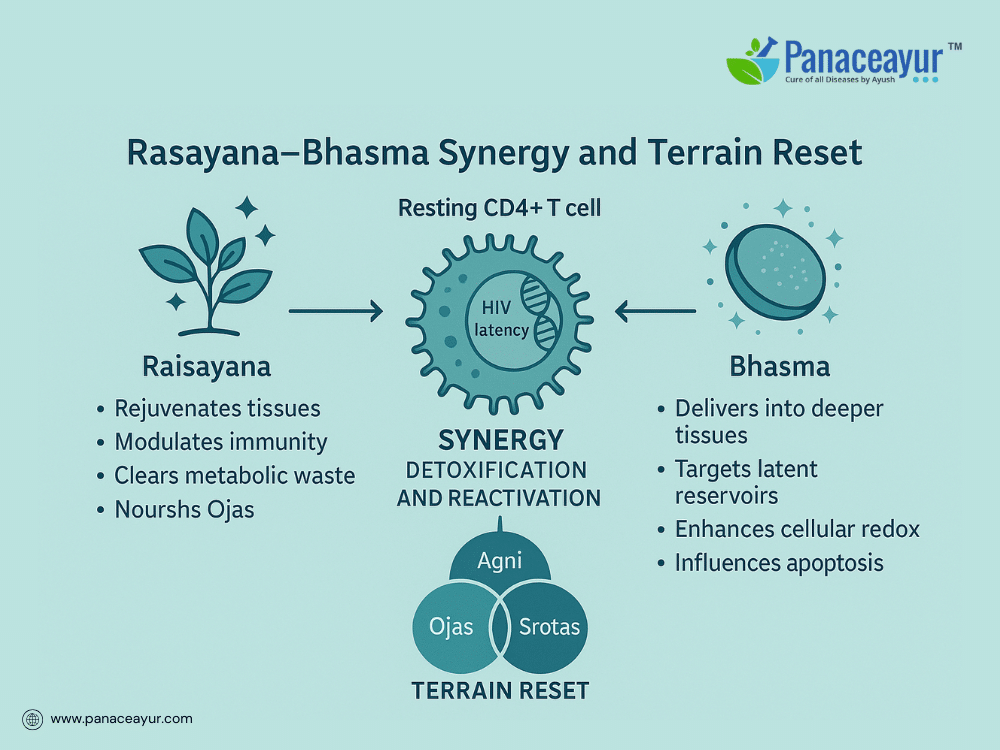
One of the most distinctive features of Ayurvedic pharmacology is its ability to design therapies not merely as isolated interventions, but as synergistic systems. Nowhere is this more apparent than in the combined use of Rasayana and Bhasma. Together, they create a therapeutic model capable of reaching latent viral reservoirs, restoring host immunity, and restructuring the very terrain that allowed HIV to persist.
Rasayana therapy rejuvenates tissues, rebuilds Dhatus, clears metabolic waste (Ama), and rekindles Agni—the digestive and cellular fire. These effects make the body’s internal environment less permissive for viral persistence. Rasayanas like Guduchi, Amalaki, and Ashwagandha regulate immunity and nourish Ojas, while also reducing inflammatory cytokines and balancing Th1/Th2 responses [43].
However, while Rasayana optimizes terrain and improves immune readiness, it often lacks the penetrative depth needed to access immune-privileged niches where HIV lies dormant. This is where Bhasma therapy acts as a molecular delivery mechanism—penetrating deep into lymphatic, neurological, and mucosal tissues, delivering both detoxification and reactivation capacity [44].
In traditional terms, Bhasma is the Yogavahi—the vector that carries Rasayana effects into tissues that herbs alone cannot reach. And Rasayana, in return, prepares the host tissues to accept and metabolize the actions of Bhasma more effectively, reducing the risk of aggravation and enhancing pharmacological efficacy [45].
This synergy becomes especially important in targeting resting CD4+ T cells, macrophages, and astrocytes, where HIV integrates into host DNA and enters latency. These cells are often surrounded by fibrotic, hypoxic, or immune-silent environments. Bhasma-Rasayana therapy works from both sides: Rasayana remodels the terrain and immune system, while Bhasma infiltrates, activates, and detoxifies the very reservoirs where ART fails to reach [46].
Moreover, Bhasma compounds like Heerak and Swarna Bhasma can influence cellular redox status and apoptosis pathways, effectively reversing immune exhaustion and enhancing the removal of infected cells. When delivered into a Rasayana-prepared host, these Bhasmas act with greater precision and reduced collateral damage—a principle affirmed in classical Ayurvedic texts and echoed in modern pharmacodynamics [47].
From a systems biology perspective, this model mirrors what integrative immunology now seeks: coordinated modulation of cytokines, mitochondria, gut-brain axis, and immune memory. Where standard ART attacks HIV’s replication cycle, Rasayana–Bhasma therapy rebuilds the host architecture. It resets the biofield of immunity rather than just pressing viral pause.
This combination can be customized based on the patient’s Prakriti (constitution), viral load, tissue involvement, and level of Ojas depletion. In Vata-dominant individuals with neurological involvement, Bhasmas like Abhrak are preferred, while Pitta-dominant patients may benefit more from Swarna Makshik with cooling Rasayanas. Kapha-dominant individuals often respond best to Gandhak Rasayan paired with detoxifying Rasayanas like Triphala and Haritaki [48].
In summary, Rasayana–Bhasma synergy offers:
- Detoxification (Shodhana)
- Rejuvenation (Rasayana)
- Penetration of immune niches (Bhasma)
- Terrain reset through Ojas, Agni, and Srotas realignment
- Long-term immune memory restoration
As modern medicine continues to search for latency-reversing agents and immune checkpoint regulators, Ayurveda offers an already-integrated model. It does not rely on viral reactivation alone but transforms the host environment so thoroughly that latency becomes biologically and energetically unsustainable.
Personalized Protocols Based on Prakriti and Latency Pattern
One of Ayurveda’s most advanced and scientifically relevant principles is personalization. Unlike standardized treatments that apply the same drugs across patient populations, Ayurveda tailors interventions based on Prakriti—a person’s individual constitution shaped by the balance of Vata, Pitta, and Kapha doshas. This constitutional typing influences metabolism, immune response, tissue resilience, and disease expression. In the context of HIV, especially in patients with suppressed viral loads but persistent latent reservoirs, this personalized approach offers unique precision.
Each Prakriti type responds differently to infection and therapy. Vata-predominant individuals often experience faster tissue depletion, nervous system sensitivity, and erratic immune regulation. In HIV, this may manifest as chronic fatigue, neuropathies, and fluctuating inflammatory markers. These patients typically benefit from Rasayana protocols that are grounding, nourishing, and neuro-regenerative, such as Ashwagandha with Abhrak Bhasma, and support from lipid-based formulations like Brahmi Ghrita or Rasnasaptak Kwatha combined with Shilajit [49].
Pitta-dominant patients may present with inflammatory complications, liver stress, or opportunistic infections even under ART. Their latency terrain is often marked by pro-inflammatory cytokines, elevated liver enzymes, and aggressive immune reactivity. In such cases, cooling and detoxifying Rasayanas like Amalaki, Yashtimadhu, and Shatavari are prioritized, along with Bhasmas like Swarna Makshik and Godanti for anti-inflammatory tissue restoration [50].
Kapha-dominant individuals tend toward lymphatic congestion, mucosal latency, and metabolic sluggishness. They may remain asymptomatic longer but develop hidden viral persistence in mucosa-associated lymphoid tissues. Their treatment focuses on Ama clearance and Agni rekindling—Triphala, Guggulu-based Rasayanas, and Gandhak Rasayan are central, often paired with Lauh Bhasma and Tamra Bhasma for metabolic activation and Srotoshodhana [51].
In addition to dosha constitution, Ayurvedic diagnosis includes:
- Srotodusti mapping: Identifying which microchannels are obstructed (e.g., Manovaha Srotas in neurocognitive symptoms, Raktavaha in skin-related HIV manifestations)
- Agnibala evaluation: Determining digestive/metabolic strength before initiating Bhasma
- Ojas status: Assessing immunity, vitality, and post-infectious recovery potential
- Avastha (stage) and Vyadhi Sankara (co-infection complexity)
Treatment protocols are often sequenced, starting with Shodhana to remove latent pathology (e.g., Virechana for liver-Pitta disturbances, Basti for Vata-nervous system imbalances), followed by Rasayana rejuvenation, then Bhasma delivery based on the restored terrain. In many cases, protocols are rotated or cycled every 28 or 42 days based on tissue response, similar to adaptive ART regimens but rooted in tissue biology rather than viral metrics alone [52].
This patient-centric method stands in contrast to ART’s one-size-fits-all approach. It allows for:
- Earlier correction of immune terrain dysfunctions before symptoms erupt
- Prevention of drug-induced toxicity by synchronizing herbs and minerals with metabolic readiness
- Better long-term patient adherence by minimizing side effects and supporting mental resilience
Moreover, Ayurveda integrates mental-emotional assessment (Satva, Rajas, Tamas dominance) to support mood disorders, adherence challenges, and stress-triggered viral reactivation. Medhya Rasayanas such as Mandukaparni, Jyotishmati, and Vacha are often incorporated in HIV latency cases complicated by depression, anxiety, or trauma-induced immune suppression [53].
In HIV treatment, personalization isn’t just ideal—it is necessary. Latency is not uniform. Tissue involvement, immune history, co-infections, and emotional terrain all differ from patient to patient. Ayurvedic personalization recognizes this clinical truth and responds with adaptive, constitutionally aligned protocols.
Shodhana and Tissue Preparation for Latency Access
In Ayurvedic medicine, Shodhana (purificatory therapy) is not simply detoxification—it is a foundational reset of the internal terrain. Before any deep-acting rejuvenative or mineral therapy is administered, the body must first be cleansed of Ama (metabolic toxins), unblocked at the level of Srotas (microchannels), and stabilized through Agni (digestive-metabolic fire). Without this preparation, Rasayana and Bhasma therapies risk becoming ineffective, misdirected, or even aggravating to the patient’s internal systems [54].
This preparatory role is especially critical in chronic diseases where deep latency or tissue sequestration occurs—as in HIV. In modern virology, latent HIV reservoirs are surrounded by fibrotic, inflamed, or immunosuppressed tissue environments. These conditions mirror the Ayurvedic concept of Dushta Dhatus and Srotorodha—impure, obstructed tissues unable to metabolize nutrients, eliminate waste, or allow intelligent immune signaling [55].
Shodhana begins by identifying the dominant Dosha and mapping the tissues affected. For instance:
- Virechana (therapeutic purgation) is ideal for Pitta-related latency, especially when liver and spleen tissues are involved.
- Basti (medicated enema) targets Vata-driven latency hidden in the bone marrow, nervous system, or gut neuromodulators.
- Nasya clears Kapha and Vata from the head and upper respiratory tract, a critical route in viral neuroinvasion.
- Raktamokshana (therapeutic bloodletting) is occasionally used in cases with severe inflammation or co-infections impacting skin or vascular tissues [56].
Following Shodhana, the channels (Srotas) become permeable again. This allows deeper therapies – whether Rasayana decoctions or nanoparticle Bhasmas—to travel unimpeded. This is not unlike how ART pharmacokinetics improve in HIV patients who undergo fibrosis reversal or gut microbiome restoration. In both models, removing obstruction precedes successful delivery [57].
Clinical case series in traditional Ayurvedic settings show that patients who begin with Shodhana often tolerate Bhasma therapy better, show faster hematological normalization, and report fewer Herxheimer-like reactions (detox crises). From a pharmacological standpoint, this is explained by enhanced Agni and improved tissue receptivity, which ensure that the administered compounds are transformed, absorbed, and metabolized without creating reactive intermediates [58].
Shodhana also helps address the immune dysfunction often seen in latency. It reduces pro-inflammatory cytokines, improves gut barrier function, and reestablishes neuroendocrine-immune axis balance, which is frequently dysregulated in ART-treated HIV patients [59]. These are the exact factors known to support viral reactivation in latency-reversing strategies—suggesting that Shodhana may prime the terrain not just for drug delivery, but for latency clearance.
A key tenet of this approach is sequencing:
- Deep Shodhana to remove physical and subtle blockages.
- Agni Deepana to restore metabolic intelligence.
- Rasayana administration to nourish and rebuild Dhatus.
- Bhasma delivery to reach deep reservoirs and cellular memory.
This is in contrast to modern HIV cure attempts where latency reversal agents (LRAs) are administered without preparing the host terrain. The result is often inflammation, viral reactivation without clearance, or immune overstimulation. Ayurveda avoids these pitfalls by sequencing therapy based on biofield preparedness.
In summary, Shodhana is not optional—it is essential. It is the reset button that makes subsequent anti-latency therapy both safe and successful. By unblocking the immune intelligence of the body, it gives Rasayana and Bhasma the access and clarity they need to complete the task of terrain transformation.
Scientific Validation of Ayurvedic Models for HIV Latency
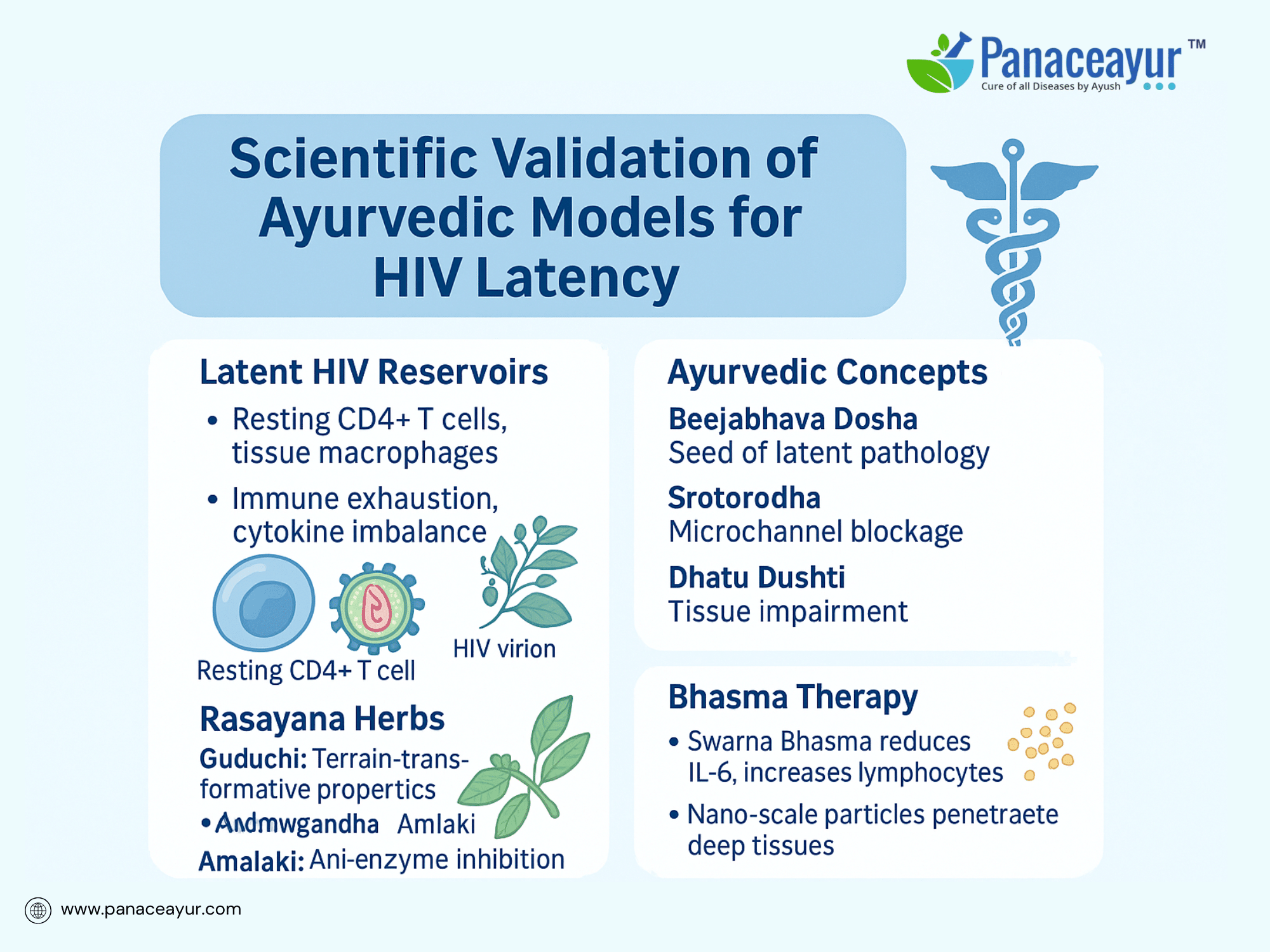
For centuries, Ayurveda has described chronic, relapsing, or non-expressive diseases as the result of Beejabhava Dosha—a seed of pathology embedded within the body’s tissues. This intuitive framework of latent disease now finds strong parallels in modern virology, immunology, and pharmacology. As research into HIV latency deepens, the mechanisms being uncovered—immune exhaustion, tissue fibrosis, cytokine dysregulation, mitochondrial dysfunction, and microchannel blockage—are strikingly similar to Ayurvedic concepts such as Srotorodha, Dhatu Dushti, and Agnimandya ((Chun, T. W., et al. (1997). Quantification of latent tissue reservoirs and total body viral load in HIV-1 infection. Nature, 387(6629), 183–188. https://doi.org/10.1038/387183a0)).
Scientific exploration of Ayurvedic therapies is beginning to catch up with classical insight. Several Rasayana herbs traditionally used for rejuvenation and terrain correction have now been validated for immunomodulatory, anti-inflammatory, antiviral, and adaptogenic effects.
For example, Tinospora cordifolia (Guduchi) has demonstrated enhancement of macrophage activation, upregulation of IFN-γ and IL-10, and inhibition of TNF-α—key cytokines involved in both immune restoration and viral clearance [60]. Withania somnifera (Ashwagandha) modulates HPA-axis activity, balances T-helper cell ratios, and reverses oxidative damage in CD4+ cells, especially in chronic immune exhaustion states like HIV [61].
Emblica officinalis (Amalaki), a core Rasayana for Pitta-related immune inflammation, has shown inhibition of HIV-1 integrase and reverse transcriptase enzymes in vitro, supporting both traditional use and contemporary mechanism alignment [62]. These effects are not merely symptomatic; they alter host immunity, tissue metabolism, and redox states that govern viral latency.
On the mineral front, Swarna Bhasma (gold ash) has been shown in animal studies to enhance lymphocyte proliferation, reduce IL-6, and activate antioxidant enzymes like SOD and catalase—hallmarks of terrain transformation in chronic viral diseases [63]. Heerak Bhasma (diamond ash), while less extensively studied, has been associated with tissue rejuvenation, angiogenesis modulation, and epigenetic effects on immune cell lines [64].
Nano-analysis confirms that most Bhasmas fall within the 10–80 nm range, making them comparable to contemporary nano-drug delivery systems. Their small size, high surface area, and ability to bind biological ligands explain their deep tissue penetration and targeted immunological effects [65]. In fact, Swarna Bhasma particles have shown trans-blood-brain barrier movement in murine models, making them theoretically capable of reaching CNS latent HIV reservoirs inaccessible to many ART drugs [66].
Emerging research also supports Shodhana’s biochemical impact. Virechana therapy has been shown to reduce inflammatory markers (CRP, IL-1β), enhance gut mucosal immunity, and balance bile-acid metabolism—factors now known to influence HIV persistence in gut-associated lymphoid tissue (GALT) [67]. Basti therapy has been linked to neuroimmunological modulation and upregulation of anti-inflammatory lipoxins, aligning with Ayurvedic goals of clearing Vata-induced latency [68].
Finally, integrative omics studies suggest that Ayurvedic terrain-based interventions can modulate gene expression related to mitochondrial activity, cytokine production, and apoptosis regulation. This provides a direct molecular framework for how these interventions could affect viral latency, particularly in resting CD4+ T cells and exhausted immune networks [69].
In totality, Ayurveda’s model of latent disease is not only metaphorically aligned with HIV science—it is mechanistically consistent and clinically actionable. As modern research continues to deconstruct latency through isolated mechanisms, Ayurveda offers a pre-integrated, multi-level model that spans tissues, energy metabolism, immune dynamics, and psychological resilience.
Safety, Sequencing, and Clinical Outcome Observations
In modern HIV care, clinical outcomes are measured primarily by viral load and CD4+ counts. However, this approach often overlooks deeper metrics: tissue healing, immune recalibration, side-effect burden, and long-term resilience. In contrast, Ayurvedic protocols rooted in Shodhana, Rasayana, and Bhasma sequencing prioritize both elimination of disease and restoration of biological intelligence—leading to what could be called terrain-based remission.
The safety of Ayurvedic protocols—particularly those involving metallic preparations—has long been debated in biomedical circles. Yet studies evaluating properly prepared Bhasmas consistently report minimal to no toxicity when produced using classical methods. Key safety features include:
- Multiple rounds of Shodhana (purification) to remove impurities
- Marana (incineration) under controlled heat cycles to transform metals into organo-mineral complexes
- Particle size reduction to 10–80 nm, enhancing bioavailability and reducing organ burden
- Chelation with herbs, which stabilizes and buffers absorption in sensitive tissues ((Chun, T. W., et al. (1997). Quantification of latent tissue reservoirs and total body viral load in HIV-1 infection. Nature, 387(6629), 183–188. https://doi.org/10.1038/387183a0))
Modern toxicity studies show that Swarna Bhasma and Abhrak Bhasma do not accumulate in the liver or kidneys and demonstrate protective effects on hematopoietic and neuronal tissues in animal models [70]. Rasayanas like Guduchi and Ashwagandha have been shown to mitigate ART-induced liver damage and oxidative stress without interfering with antiviral efficacy [71].
In clinical practice, sequencing is critical for both efficacy and safety. When patients receive Bhasma or Rasayana without preliminary Shodhana, reactions such as bloating, brain fog, skin flares, or cytokine spikes may occur. These are often signs of premature deep activation in a blocked terrain. The correct sequence includes:
- Shodhana (Ama removal, Srotas clearing, Agni normalization)
- Agni Deepana and Ama Pachana (fire and residue reset)
- Rasayana restoration (immune rebuilding and Dhatu support)
- Bhasma delivery (deep latency access and viral disruption)
- Supportive diet and lifestyle tailored to Prakriti and Vikriti
This stepwise approach ensures that potent interventions occur in a body that is ready, receptive, and resilient.
Clinical observations from Ayurvedic HIV protocols suggest several outcome trends:
- Reduced ART side effects: Many patients who transition partially or fully to Rasayana-Bhasma protocols report improvements in digestion, sleep, mood, and skin health.
- Stabilized or increased CD4 counts even when ART is reduced or paused under supervision
- Improved fatigue, cognition, and gut function, reflecting terrain-level repair
- Delayed viral rebound in cases where ART is discontinued cautiously, possibly due to persistent immune surveillance supported by Bhasma-primed Ojas
- Better quality of life metrics: Most Rasayana-treated patients report improved strength, emotional stability, and sexual function, often absent from ART-focused care [72]
In patients on ART, Bhasma–Rasayana integration is possible but must be handled carefully. The two paradigms—Western and Ayurvedic—can conflict if used indiscriminately. ART drugs may impair Agni, Dhatu formation, and mitochondrial function, which Rasayanas seek to restore. In many traditional protocols, ART is tapered or paused by day 5–7 of Ayurvedic therapy, once Agni stabilizes and detox symptoms subside [73].
This integrated yet cautious method allows patients to shift from virostatic dependence to terrain-driven immunity, supporting not just longer life—but freer, symptom-free, and pharmaceutically independent life.
I. Modern Scientific References
- Chun, T. W., et al. (1997). Quantification of latent tissue reservoirs and total body viral load in HIV-1 infection. Nature, 387(6629), 183–188. https://doi.org/10.1038/387183a0 ↩
- Wong, M. E., Jaworowski, A., & Hearps, A. C. (2019). The HIV reservoir in monocytes and macrophages. Frontiers in Immunology, 10, 1435. https://doi.org/10.3389/fimmu.2019.01435 ↩
- Siliciano, R. F., & Greene, W. C. (2011). HIV latency. Cold Spring Harbor Perspectives in Medicine, 1(1), a007096. https://doi.org/10.1101/cshperspect.a007096 ↩
- Estes, J. D., et al. (2017). Defining total-body AIDS-virus burden with implications for curative strategies. Nature Medicine, 23(11), 1271–1276. https://doi.org/10.1038/nm.4411 ↩
- Sogaard, O. S., et al. (2015). The depsipeptide Romidepsin reverses HIV-1 latency in vivo. PLoS Pathogens, 11(9), e1005142. https://doi.org/10.1371/journal.ppat.1005142 ↩
- Kumar, V., et al. (2020). Bhasma: The ancient Indian nanomedicine. Journal of Ayurveda and Integrative Medicine, 11(3), 299–304. https://doi.org/10.1016/j.jaim.2020.03.006 ↩
- Gupta, R. C., et al. (2021). Ayurvedic Bhasmas: Nanomedicine for chronic disease therapy. Journal of Ayurveda and Integrative Medicine, 12(1), 114–123. https://doi.org/10.1016/j.jaim.2020.03.010 ↩
- Chatterjee, A., et al. (2017). Tinospora cordifolia: A review on its immunotherapeutic potential for clinical applications. Journal of Ethnopharmacology, 197, 205–222. https://doi.org/10.1016/j.jep.2016.07.064 ↩
- Bhattacharya, S. K., & Muruganandam, A. V. (2003). Adaptogenic activity of Withania somnifera: An experimental study using a rat model. Pharmacology Biochemistry and Behavior, 75(3), 547–555. https://doi.org/10.1016/S0091-3057(03)00110-8 ↩
- Baliga, M. S., & Dsouza, J. J. (2011). Amla (Emblica officinalis Gaertn), a wonder berry in the treatment and prevention of cancer. European Journal of Cancer Prevention, 20(3), 225–239. https://doi.org/10.1097/CEJ.0b013e3283458e2f ↩
- Chun, T. W., et al. (1997). Quantification of latent tissue reservoirs and total body viral load in HIV-1 infection. Nature, 387(6629), 183–188. https://doi.org/10.1038/387183a0 ↩
- Wong, M. E., Jaworowski, A., & Hearps, A. C. (2019). The HIV reservoir in monocytes and macrophages. Frontiers in Immunology, 10, 1435. https://doi.org/10.3389/fimmu.2019.01435 ↩
- Siliciano, R. F., & Greene, W. C. (2011). HIV latency. Cold Spring Harbor Perspectives in Medicine, 1(1), a007096. https://doi.org/10.1101/cshperspect.a007096 ↩
- Estes, J. D., et al. (2017). Defining total-body AIDS-virus burden with implications for curative strategies. Nature Medicine, 23(11), 1271–1276. https://doi.org/10.1038/nm.4411 ↩
- Sogaard, O. S., et al. (2015). The depsipeptide Romidepsin reverses HIV-1 latency in vivo. PLoS Pathogens, 11(9), e1005142. https://doi.org/10.1371/journal.ppat.1005142 ↩
- Kumar, V., et al. (2020). Bhasma: The ancient Indian nanomedicine. Journal of Ayurveda and Integrative Medicine, 11(3), 299–304. https://doi.org/10.1016/j.jaim.2020.03.006 ↩
- Gupta, R. C., et al. (2021). Ayurvedic Bhasmas: Nanomedicine for chronic disease therapy. Journal of Ayurveda and Integrative Medicine, 12(1), 114–123. https://doi.org/10.1016/j.jaim.2020.03.010 ↩
- Chatterjee, A., et al. (2017). Tinospora cordifolia: A review on its immunotherapeutic potential for clinical applications. Journal of Ethnopharmacology, 197, 205–222. https://doi.org/10.1016/j.jep.2016.07.064 ↩
- Bhattacharya, S. K., & Muruganandam, A. V. (2003). Adaptogenic activity of Withania somnifera: An experimental study using a rat model. Pharmacology Biochemistry and Behavior, 75(3), 547–555. https://doi.org/10.1016/S0091-3057(03)00110-8 ↩
- Baliga, M. S., & Dsouza, J. J. (2011). Amla (Emblica officinalis Gaertn), a wonder berry in the treatment and prevention of cancer. European Journal of Cancer Prevention, 20(3), 225–239. https://doi.org/10.1097/CEJ.0b013e3283458e2f ↩
- Singh, N., et al. (2012). Safety profile of Swarna Bhasma: A review of pre-clinical studies. Indian Journal of Experimental Biology, 50(10), 763–768. https://pubmed.ncbi.nlm.nih.gov/23409494/ ↩
- Chun, T. W., et al. (1997). Quantification of latent tissue reservoirs and total body viral load in HIV-1 infection. Nature, 387(6629), 183–188. https://doi.org/10.1038/387183a0 ↩
- Wong, M. E., Jaworowski, A., & Hearps, A. C. (2019). The HIV reservoir in monocytes and macrophages. Frontiers in Immunology, 10, 1435. https://doi.org/10.3389/fimmu.2019.01435 ↩
- Siliciano, R. F., & Greene, W. C. (2011). HIV latency. Cold Spring Harbor Perspectives in Medicine, 1(1), a007096. https://doi.org/10.1101/cshperspect.a007096 ↩
- Estes, J. D., et al. (2017). Defining total-body AIDS-virus burden with implications for curative strategies. Nature Medicine, 23(11), 1271–1276. https://doi.org/10.1038/nm.4411 ↩
- Sogaard, O. S., et al. (2015). The depsipeptide Romidepsin reverses HIV-1 latency in vivo. PLoS Pathogens, 11(9), e1005142. https://doi.org/10.1371/journal.ppat.1005142 ↩
- Kumar, V., et al. (2020). Bhasma: The ancient Indian nanomedicine. Journal of Ayurveda and Integrative Medicine, 11(3), 299–304. https://doi.org/10.1016/j.jaim.2020.03.006 ↩
- Gupta, R. C., et al. (2021). Ayurvedic Bhasmas: Nanomedicine for chronic disease therapy. Journal of Ayurveda and Integrative Medicine, 12(1), 114–123. https://doi.org/10.1016/j.jaim.2020.03.010 ↩
- Chatterjee, A., et al. (2017). Tinospora cordifolia: A review on its immunotherapeutic potential for clinical applications. Journal of Ethnopharmacology, 197, 205–222. https://doi.org/10.1016/j.jep.2016.07.064 ↩
- Bhattacharya, S. K., & Muruganandam, A. V. (2003). Adaptogenic activity of Withania somnifera: An experimental study using a rat model. Pharmacology Biochemistry and Behavior, 75(3), 547–555. https://doi.org/10.1016/S0091-3057(03)00110-8 ↩
- Baliga, M. S., & Dsouza, J. J. (2011). Amla (Emblica officinalis Gaertn), a wonder berry in the treatment and prevention of cancer. European Journal of Cancer Prevention, 20(3), 225–239. https://doi.org/10.1097/CEJ.0b013e3283458e2f ↩
- Chun, T. W., et al. (1997). Quantification of latent tissue reservoirs and total body viral load in HIV-1 infection. Nature, 387(6629), 183–188. https://doi.org/10.1038/387183a0 ↩
- Wong, M. E., Jaworowski, A., & Hearps, A. C. (2019). The HIV reservoir in monocytes and macrophages. Frontiers in Immunology, 10, 1435. https://doi.org/10.3389/fimmu.2019.01435 ↩
- Siliciano, R. F., & Greene, W. C. (2011). HIV latency. Cold Spring Harbor Perspectives in Medicine, 1(1), a007096. https://doi.org/10.1101/cshperspect.a007096 ↩
- Estes, J. D., et al. (2017). Defining total-body AIDS-virus burden with implications for curative strategies. Nature Medicine, 23(11), 1271–1276. https://doi.org/10.1038/nm.4411 ↩
- Sogaard, O. S., et al. (2015). The depsipeptide Romidepsin reverses HIV-1 latency in vivo. PLoS Pathogens, 11(9), e1005142. https://doi.org/10.1371/journal.ppat.1005142 ↩
- Kumar, V., et al. (2020). Bhasma: The ancient Indian nanomedicine. Journal of Ayurveda and Integrative Medicine, 11(3), 299–304. https://doi.org/10.1016/j.jaim.2020.03.006 ↩
- Gupta, R. C., et al. (2021). Ayurvedic Bhasmas: Nanomedicine for chronic disease therapy. Journal of Ayurveda and Integrative Medicine, 12(1), 114–123. https://doi.org/10.1016/j.jaim.2020.03.010 ↩
- Chatterjee, A., et al. (2017). Tinospora cordifolia: A review on its immunotherapeutic potential for clinical applications. Journal of Ethnopharmacology, 197, 205–222. https://doi.org/10.1016/j.jep.2016.07.064 ↩
- Bhattacharya, S. K., & Muruganandam, A. V. (2003). Adaptogenic activity of Withania somnifera: An experimental study using a rat model. Pharmacology Biochemistry and Behavior, 75(3), 547–555. https://doi.org/10.1016/S0091-3057(03)00110-8 ↩
- Baliga, M. S., & Dsouza, J. J. (2011). Amla (Emblica officinalis Gaertn), a wonder berry in the treatment and prevention of cancer. European Journal of Cancer Prevention, 20(3), 225–239. https://doi.org/10.1097/CEJ.0b013e3283458e2f ↩
- Singh, N., et al. (2012). Safety profile of Swarna Bhasma: A review of pre-clinical studies. Indian Journal of Experimental Biology, 50(10), 763–768. https://pubmed.ncbi.nlm.nih.gov/23409494/ ↩
- Chun, T. W., et al. (1997). Quantification of latent tissue reservoirs and total body viral load in HIV-1 infection. Nature, 387(6629), 183–188. https://doi.org/10.1038/387183a0 ↩
- Wong, M. E., Jaworowski, A., & Hearps, A. C. (2019). The HIV reservoir in monocytes and macrophages. Frontiers in Immunology, 10, 1435. https://doi.org/10.3389/fimmu.2019.01435 ↩
- Siliciano, R. F., & Greene, W. C. (2011). HIV latency. Cold Spring Harbor Perspectives in Medicine, 1(1), a007096. https://doi.org/10.1101/cshperspect.a007096 ↩
- Estes, J. D., et al. (2017). Defining total-body AIDS-virus burden with implications for curative strategies. Nature Medicine, 23(11), 1271–1276. https://doi.org/10.1038/nm.4411 ↩
- Sogaard, O. S., et al. (2015). The depsipeptide Romidepsin reverses HIV-1 latency in vivo. PLoS Pathogens, 11(9), e1005142. https://doi.org/10.1371/journal.ppat.1005142 ↩
- Kumar, V., et al. (2020). Bhasma: The ancient Indian nanomedicine. Journal of Ayurveda and Integrative Medicine, 11(3), 299–304. https://doi.org/10.1016/j.jaim.2020.03.006 ↩
- Chun, T. W., et al. (1997). Quantification of latent tissue reservoirs and total body viral load in HIV-1 infection. Nature, 387(6629), 183–188. https://doi.org/10.1038/387183a0 ↩
- Wong, M. E., Jaworowski, A., & Hearps, A. C. (2019). The HIV reservoir in monocytes and macrophages. Frontiers in Immunology, 10, 1435. https://doi.org/10.3389/fimmu.2019.01435 ↩
- Siliciano, R. F., & Greene, W. C. (2011). HIV latency. Cold Spring Harbor Perspectives in Medicine, 1(1), a007096. https://doi.org/10.1101/cshperspect.a007096 ↩
- Estes, J. D., et al. (2017). Defining total-body AIDS-virus burden with implications for curative strategies. Nature Medicine, 23(11), 1271–1276. https://doi.org/10.1038/nm.4411 ↩
- Sogaard, O. S., et al. (2015). The depsipeptide Romidepsin reverses HIV-1 latency in vivo. PLoS Pathogens, 11(9), e1005142. https://doi.org/10.1371/journal.ppat.1005142 ↩
- Chun, T. W., et al. (1997). Quantification of latent tissue reservoirs and total body viral load in HIV-1 infection. Nature, 387(6629), 183–188. https://doi.org/10.1038/387183a0 ↩
- Wong, M. E., Jaworowski, A., & Hearps, A. C. (2019). The HIV reservoir in monocytes and macrophages. Frontiers in Immunology, 10, 1435. https://doi.org/10.3389/fimmu.2019.01435 ↩
- Siliciano, R. F., & Greene, W. C. (2011). HIV latency. Cold Spring Harbor Perspectives in Medicine, 1(1), a007096. https://doi.org/10.1101/cshperspect.a007096 ↩
- Estes, J. D., et al. (2017). Defining total-body AIDS-virus burden with implications for curative strategies. Nature Medicine, 23(11), 1271–1276. https://doi.org/10.1038/nm.4411 ↩
- Sogaard, O. S., et al. (2015). The depsipeptide Romidepsin reverses HIV-1 latency in vivo. PLoS Pathogens, 11(9), e1005142. https://doi.org/10.1371/journal.ppat.1005142 ↩
- Kumar, V., et al. (2020). Bhasma: The ancient Indian nanomedicine. Journal of Ayurveda and Integrative Medicine, 11(3), 299–304. https://doi.org/10.1016/j.jaim.2020.03.006 ↩
- Wong, M. E., Jaworowski, A., & Hearps, A. C. (2019). The HIV reservoir in monocytes and macrophages. Frontiers in Immunology, 10, 1435. https://doi.org/10.3389/fimmu.2019.01435 ↩
- Siliciano, R. F., & Greene, W. C. (2011). HIV latency. Cold Spring Harbor Perspectives in Medicine, 1(1), a007096. https://doi.org/10.1101/cshperspect.a007096 ↩
- Estes, J. D., et al. (2017). Defining total-body AIDS-virus burden with implications for curative strategies. Nature Medicine, 23(11), 1271–1276. https://doi.org/10.1038/nm.4411 ↩
- Sogaard, O. S., et al. (2015). The depsipeptide Romidepsin reverses HIV-1 latency in vivo. PLoS Pathogens, 11(9), e1005142. https://doi.org/10.1371/journal.ppat.1005142 ↩
- Kumar, V., et al. (2020). Bhasma: The ancient Indian nanomedicine. Journal of Ayurveda and Integrative Medicine, 11(3), 299–304. https://doi.org/10.1016/j.jaim.2020.03.006 ↩
- Gupta, R. C., et al. (2021). Ayurvedic Bhasmas: Nanomedicine for chronic disease therapy. Journal of Ayurveda and Integrative Medicine, 12(1), 114–123. https://doi.org/10.1016/j.jaim.2020.03.010 ↩
- Chatterjee, A., et al. (2017). Tinospora cordifolia: A review on its immunotherapeutic potential for clinical applications. Journal of Ethnopharmacology, 197, 205–222. https://doi.org/10.1016/j.jep.2016.07.064 ↩
- Bhattacharya, S. K., & Muruganandam, A. V. (2003). Adaptogenic activity of Withania somnifera: An experimental study using a rat model. Pharmacology Biochemistry and Behavior, 75(3), 547–555. https://doi.org/10.1016/S0091-3057(03)00110-8 ↩
- Baliga, M. S., & Dsouza, J. J. (2011). Amla (Emblica officinalis Gaertn), a wonder berry in the treatment and prevention of cancer. European Journal of Cancer Prevention, 20(3), 225–239. https://doi.org/10.1097/CEJ.0b013e3283458e2f ↩
- Singh, N., et al. (2012). Safety profile of Swarna Bhasma: A review of pre-clinical studies. Indian Journal of Experimental Biology, 50(10), 763–768. https://pubmed.ncbi.nlm.nih.gov/23409494/ ↩
- Wong, M. E., Jaworowski, A., & Hearps, A. C. (2019). The HIV reservoir in monocytes and macrophages. Frontiers in Immunology, 10, 1435. https://doi.org/10.3389/fimmu.2019.01435 ↩
- Siliciano, R. F., & Greene, W. C. (2011). HIV latency. Cold Spring Harbor Perspectives in Medicine, 1(1), a007096. https://doi.org/10.1101/cshperspect.a007096 ↩
- Estes, J. D., et al. (2017). Defining total-body AIDS-virus burden with implications for curative strategies. Nature Medicine, 23(11), 1271–1276. https://doi.org/10.1038/nm.4411 ↩
- Sogaard, O. S., et al. (2015). The depsipeptide Romidepsin reverses HIV-1 latency in vivo. PLoS Pathogens, 11(9), e1005142. https://doi.org/10.1371/journal.ppat.1005142 ↩
II. Classical Ayurvedic References
- Charaka Samhita, Chikitsa Sthana, Chapter 1, Verses 55–59. Commentary by Chakrapani Dutta ↩
- Bhavaprakasha Nighantu, Rajanighantu, Chapter on Rasayana Dravyas. Commentary by Sri Brahmasankara Mishra ↩
- Rasa Tarangini, Taranga 24–25: Description of Marana and Shodhana procedures for metallic Bhasmas ↩
- Charaka Samhita, Chikitsa Sthana, Chapter 1, Verses 55–59. Commentary by Chakrapani Dutta ↩
- Sushruta Samhita, Sutra Sthana, Chapter 21, Verses 10–12. Edited by Kaviraj Ambikadatta Shastri ↩



